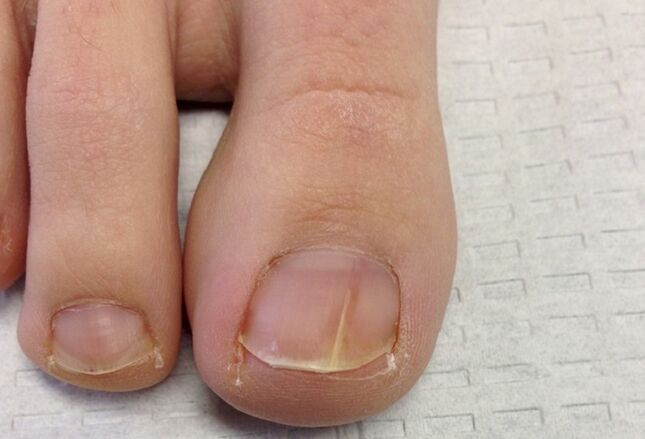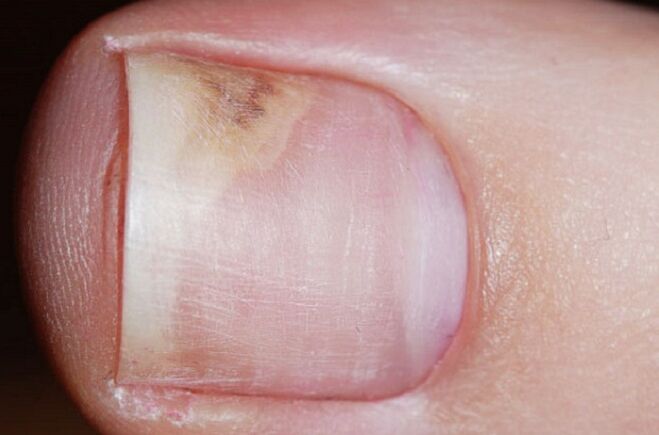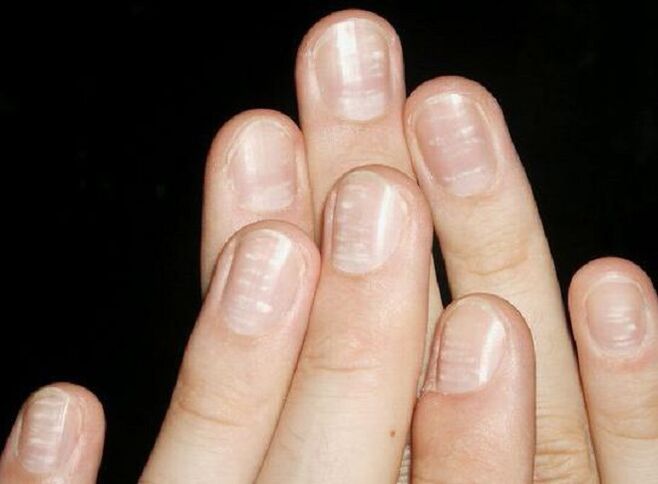Nail fungus is a disease that causes many problems to people. Severe itching, burning and aesthetic problems associated with the unsightly appearance of the claws are not the whole list of problems caused by this disease. The longer you ignore the problem, the more advanced the disease becomes and the appearance of your nails becomes uglier. In addition, the entire body is gradually poisoned by waste products of fungal microflora. But how not to miss the initial stages of nail fungus, which is much easier and cheaper to treat than the advanced stages? It is necessary to carefully monitor the condition of not only the nails, but also the skin of the hands and feet. In this article we will talk about how not to trigger the disease and what you can do at the beginning so that over time your beautiful, pink nails do not turn into the crooked claws of Baba Yaga.

Why does the initial stage of nail fungus occur?
Older people and people with weakened immune systems are most commonly affected by infection. At the same time, no one is immune from fungal diseases: even a child can "infect" an unpleasant disease.
Fungal spores are ubiquitous in the modern world, they are extremely persistent and survive on the soil surface even at low temperatures. But most of all they "love" warmth and humidity, where they multiply extremely quickly. Warm public places where there is a lot of foot traffic are the preferred habitats of the fungus. Baths, saunas, swimming pools, fitness clubs: As soon as a person with a fungus enters thesePlaces you visit, tiny flakes of skin infected with the infection appear on almost every surface. Imagine how often you visit these establishments and consider yourself lucky if you are reading this article because of the general development and not because of the needto treat mycoses in the early stages.
Sometimes it is enough to walk barefoot in the bathhouse or put on someone else's flip-flops and you can make an appointment with a dermatologist or mycologist. Of course, you should not worry in advance: the infection takes root in the body when the immune system is weakened or there are cracks, calluses or wounds on the skin. By the way, public transport, which we use several times a day for long periods of time, is also a dangerous habitat for fungal spores.
The disease can be "contagious" in a nail salon, and both customers and employees are exposed to this danger. The use of poorly sterilized instruments often leads to a fungal infection.
Many chronic illnesses can also cause unpleasant symptoms.
Wearing uncomfortable, tight and airtight shoes made from non-natural materials also often causes an unpleasant infection. The foot sweats in such shoes and a very favorable environment for fungal spores is created.
Signs of nail plate fungus
The initial stage of onychomycosis fungus is most often not obvious, so people who are inattentive to themselves may notice problems with their nails when the nails are already severely destroyed and treatment will cost a significant amount.
So what symptoms of nail fungus on hands and feet can be recognized almost immediately? In the initial stages of a fungal disease, the nail retains its usual pink color, the nail plate is smooth and shiny. Gradually, the structure of the nail partially thickens, laminations and small destruction appear. There are different types of fungi, each of which can have specific symptoms, but there are common signs of fungal disease.
How does nail fungus develop on toenails and toenails? The symptoms are approximately the same: If the nail plate is still smooth and pink, the initial stage of an infection with the fungus can be recognized by severe itching. The affected areas itch, making it very difficult to carry out normal everyday activities. Itching and burning can be felt directly on the nails as well as on the skin. There is often a pungent, unpleasant smell.
The skin between the fingers becomes red and irritated. Little by little, the natural shine of the nail plate disappears, it becomes cloudy and the nail bed is difficult to see through. The nail becomes uneven, bumpy or wavy, which can be clearly seen both tactilely and visually. There is a gap between the nail and the nail bed that is easy to see. Some areas of the nail become yellowish or even brown.
The initial stage of mycosis of the nail plate can sometimes be recognized by peeling, brittle nails. Of course, peeling nails does not always mean that the nails are "sick", but often this is a harbinger of a fungal infection. In addition, we have already said that infectious spores penetrate through damaged skin.
What does toenail fungus look like – the early stages? Photos will be no less informative:

Fingernail fungus - the initial stage, looks like this: The nail also becomes uneven and dull, and whitish spots also appear. Most often, this type of disease occurs in women on the "active" arm. The right hands of right-handed people are particularly susceptible to this unpleasant disease, as they spend the longest time in an aggressive environment and, as a result, the nails quickly thin and are destroyed.
A change in plate thickness in the initial stages of a fungal infection is typical for nails, as well as hands and feet. Depending on the type of fungus and the cause of the disease, the plates can thicken or, conversely, thin out.
Photos of fungus on fingernails in the initial stages are no less impressive:

Treatment of nail fungus in the early stages
Like other diseases, nail fungus responds better to treatment in the early stages. In this case, you can get by with products for external use, which, by the way, are not cheap. There are numerous local remedies available to resolve the problem. The earlier the procedures are started, the less likely the infection is to develop further.
The medications are applied either directly to the nail or to the skin nearby. Nail fungus varnishes are effective remedies that work quickly and are very easy to use. Such preparations penetrate deep into the nail and, due to their texture, remain on it for a long time. The choice of medication depends on the type of fungus.
Antifungal drops also penetrate deep into the nail tissue and there is also a large selection of products. They disinfect nail plates, kill bacteria and prevent the reproduction of fungal spores. Drops help to cure the initial stage of nail fungus.
Lotions are less common, but can also be effective early on. They act on the surface of the nail plate.
Creams against nail fungus are widely used. Mainly intended for treating the skin around damaged plates. With their help, infections are prevented from spreading to undamaged areas, including new nails.
A special spray is used to prevent the disease and as part of therapy. Or feet and shoes are treated.
The initial stage of mycosis is treated mainly with local medications; as the disease progresses, doctors prescribe medications to be taken orally. Such drugs are effective when a small part of the nail plate is affected by the infection.
Modern medicine offers a wide range of means to eliminate the disease. An expensive but effective method in the initial stages is laser therapy. Devices with laser radiation are directed at the damaged areas.
In the early stages of nail fungus, only four such procedures may be required. However, this method must be used in combination with the medications described above.
During ozone therapy, the tissue is saturated with ozone. Special injections are given into the skin near the affected nail. This procedure helps to delay the development of the fungus and prevent its spores from multiplying.
Of course, you should not forget about folk remedies for treating nail fungus in the initial stages. There are a lot of them. Traditional methods are good because they are easy to use and economical. For example, treating fungus with salt and soda is very effective in the initial stages of the disease.
Prevention measures
Fungi are very difficult to cure: it requires a lot of time, effort and money, and treatment sometimes drags on for many years. Therefore, it is necessary to take precautions so as not to catch an unpleasant disease.
It is extremely important to pay attention to personal hygiene: never wear other people's shoes. If you go to a shoe store, try on only your own socks and do not use those offered by the sellers. Of course, you can't try on shoes barefoot.
After traveling on public transport, it is necessary to wash your hands thoroughly with soap. It is best to wash your nails with tar soap. Use preventative measures, there are many. Treat your shoes regularly with antifungal sprays.
When visiting a nail salon, it is better to always have your own set of tools with you, which also needs to be disinfected regularly.
It is important to wash your socks and tights every day and then iron them well. Bedding should be washed frequently at high temperatures.
If the fungus actually affects the nails, it is necessary to protect your loved ones from the same fate. The fungus is not transmitted through close contact between a sick person and a healthy person, but can easily spread through shared objects and surfaces. Regularly treat the bathroom with disinfectants: the bathtub itself, carpets and floors.


















